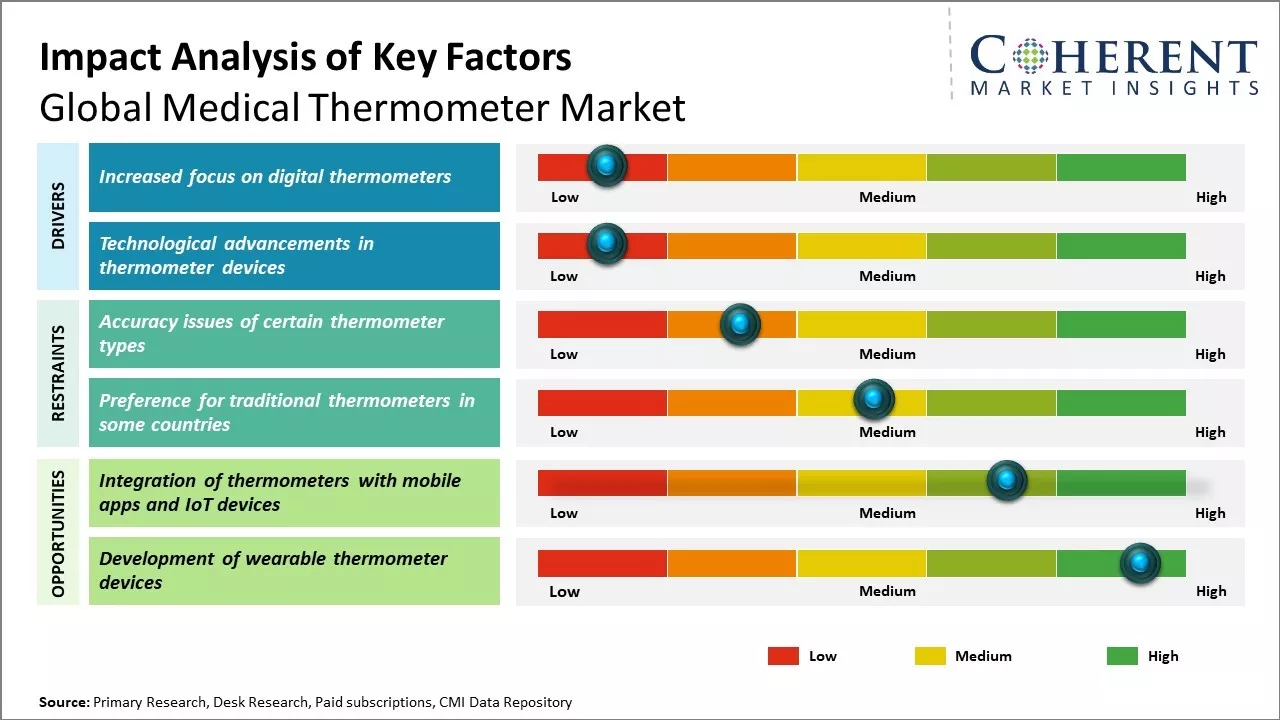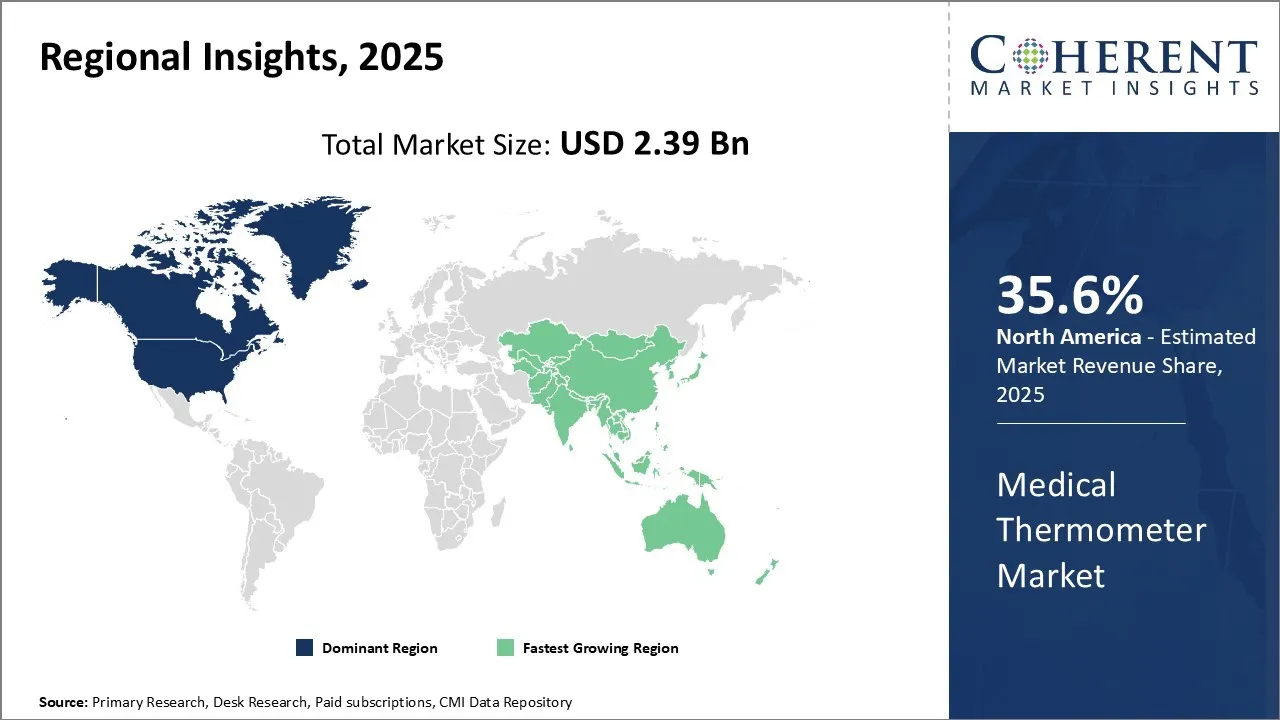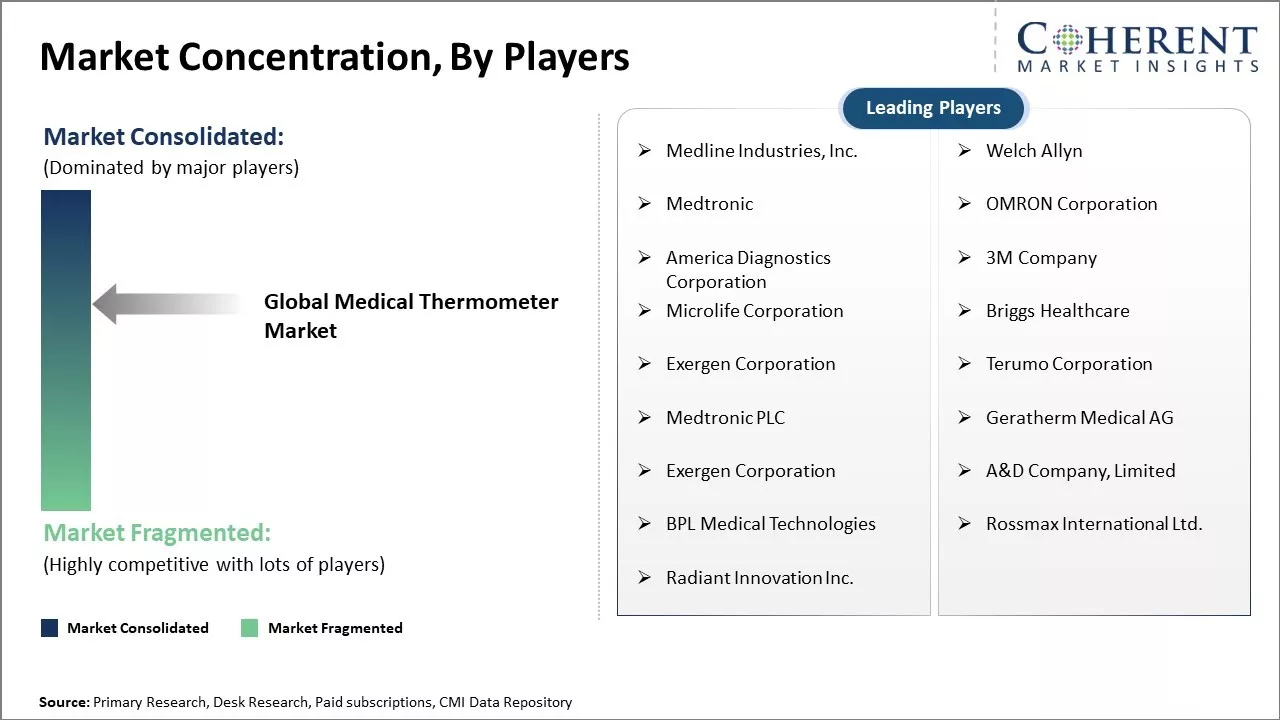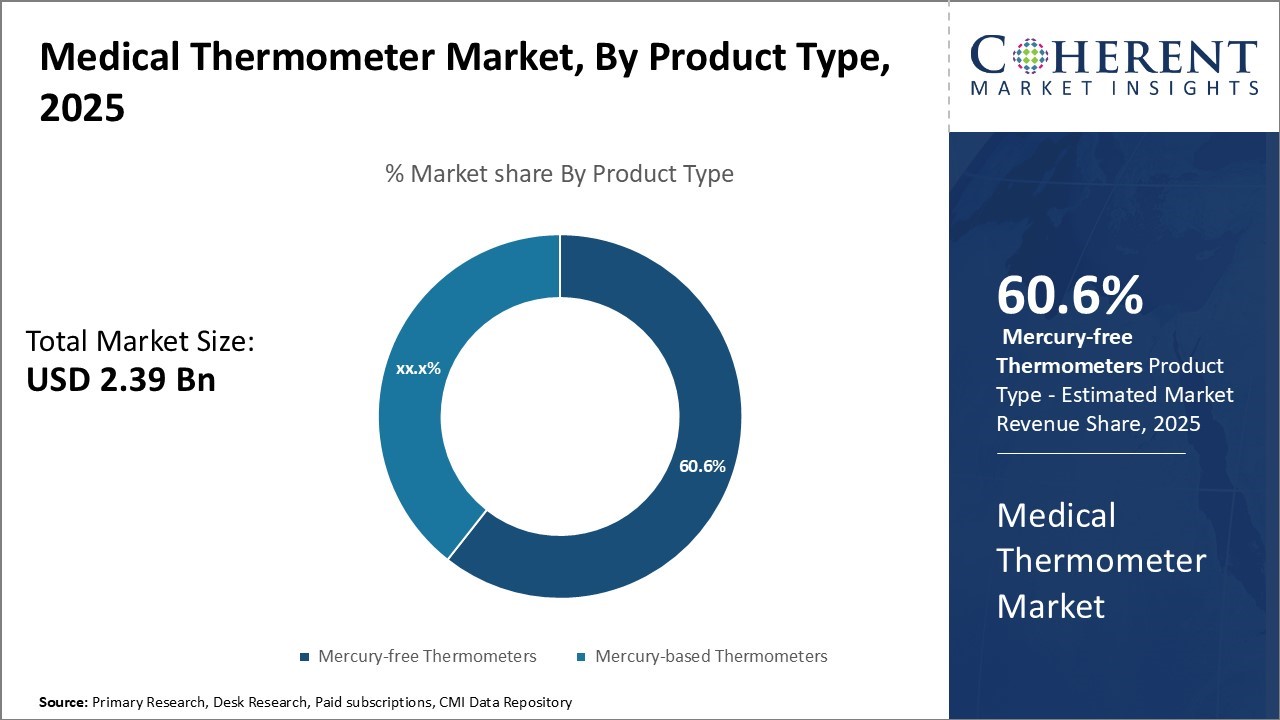Medical Thermometer Market Size and Forecast – 2025 to 2032
The global medical thermometer market is estimated to be valued at USD 2.39 Bn in 2025 and is expected to reach USD 4.26 Bn by 2032, exhibiting a compound annual growth rate (CAGR) of 8.6% from 2025 to 2032.

To learn more about this report, Download Free Sample
Key Takeaways
- Based on Product Type, Mercury-free thermometers segment is projected to account for 60.6% of the global market in 2025, owing to stringent regulations regarding the use of mercury
- Based on End User, the Hospitals and Clinics segment is projected to command 35.5% share of the market in 2025, due to high consumption across healthcare facilities.
- Based on Region, North America is set to dominate the global market with a 35.6% share in 2025.
Market Overview
The medical thermometer market demand is expected to showcase positive growth over the forecast period owing to the increasing prevalence of fever and other illnesses globally. The medical thermometer market is anticipated to witness significant demand in the coming years due to the rising trend of self-monitoring of health conditions at home settings. Technological advancements such as smart thermometers with advanced connectivity options are gaining popularity among consumers. Fever detection thermometers are finding increasing applications in hospitals, clinics as well as for personal use at home to measure body temperature accurately and precisely.
Current Events and Its Impact
|
Current Event |
Description and its Impact |
|
Advanced Digital Health Technology Integration |
|
|
Regulatory Framework Evolution and Compliance Changes |
|
Uncover macros and micros vetted on 75+ parameters: Get instant access to report
Pricing Analysis
Digital/Electronic Thermometers
- Consumer Range: $3 - $25
- Professional Range: $15 - $75
- Key differentiators: Response time, accuracy, memory functions
Infrared/Non-Contact Thermometers
- Consumer Range: $15 - $80
- Professional Range: $50 - $300
- Premium models: $300 - $500+
Smart/Connected Thermometers
- Consumer Range: $25 - $150
- Professional Range: $100 - $400
Traditional Mercury/Analog
- Consumer Range: $2 - $15
- Professional Range: $10 - $40
Medical Thermometer Market Trends
Increased focus on digital thermometers
Medical thermometers have gained increased importance as one of the primary tools for the screening of possible infections and monitoring body temperature. This has propelled more consumers and healthcare providers to adopt digital medical thermometers which are faster, more convenient and hygienic to use compared to traditional mercury-based thermometers.
Digital thermometers provide instant temperature readings on an easy-to-read digital display without any exposure to mercury, thus minimizing infection risks. They also store past temperature readings which can be consulted for tracking trends over time. These features have made them a preferred choice for regular check-ups of patients in hospitals and fever screening in public places.
Technological advancements in thermometer devices
Technological advancements are playing a vital role in driving the growth of the global medical thermometer market. Traditional mercury and digital thermometers are being rapidly replaced by advanced smart thermometers that provide swift, accurate, and convenient temperature readings.
Smart thermometers connect to mobile apps via Bluetooth and allow remote temperature monitoring as well as logging of readings over time for diagnosis and record keeping. This eliminates inaccuracies associated with manual readings and offers valuable health analytics to both patients and healthcare providers. Companies are investing heavily in developing advanced infrared thermometers that provide contactless readings in a matter of seconds.
Medical Thermometer Market Insights, By Product Type - Adoption of Safety Standards Drives the Growth of Mercury-free Thermometers
Mercury-free thermometers are expected to contribute the highest share of the global medical thermometer market. This segment is expected to account for 60.6% of the market share in 2025 due to stringent regulations regarding the use of mercury. Mercury is a hazardous material that can pose serious health risks if released into the environment or absorbed through the skin. Several international organizations have imposed bans and restrictions on the use of mercury in medical devices to protect both users and the environment.
Stringent safety standards issued by regulatory bodies like the USFDA in the U.S. have driven major thermometer manufacturers to shift away from mercury-based products. Non-mercury thermometers are now mandatory in most healthcare facilities and hospitals across developed markets. This ensures a safe experience for patients and medical staff while meeting regulatory compliance. The push for mercury-free alternatives is also driven by increased awareness among consumers regarding mercury poisoning. For instance, in May 2024, the governments of Albania, Burkina Faso, India, Montenegro, and Uganda launched a $134 million initiative to eliminate mercury use in medical devices due to its toxic risks to health and the environment. Such initiatives are accelerating the medical thermometer market demand.
Medical Thermometer Market Insights, By End User - Hospitals Drive High Usage of Thermometers
The hospitals and clinics segment is expected to contribute the leading share in the global medical thermometer industry, accounting for 35.5% of the market share in 2025 owing to high consumption across healthcare facilities. Fever detection and temperature monitoring is an essential diagnostic procedure conducted millions of times daily worldwide in hospitals, clinics, and medical examination centers.
Thermometers are used extensively not just for patients but also for screening caregivers and visitors to healthcare premises. International healthcare organizations recommend routine temperature checks for all individuals entering hospitals as an effective screening method for early detection of viral illnesses. This drives bulk recurring procurement of thermometers by hospitals.
Public health programs in several countries also mandate the regular monitoring of children and elderly individuals living in healthcare facilities. Additionally, post-surgery divisions, intensive care, and neonatal units have heightened the requirements for close patient temperature surveillance. Large hospitals therefore maintain sizable thermometer inventories for round-the-clock usage.
For instance, Medical Indicators announced that NexTemp® Go – a fast, safe, and transportable single-use thermometer for a generation on the go – is available to Canadian hospitals and healthcare institutions. Such developments are propelling the medical thermometer market share.
Regional Insights

To learn more about this report, Download Free Sample
North America Medical Thermometer Market Analysis & Trends
North America has traditionally dominated the global medical thermometer market. The region is expected to account for 35.6% of the market share in 2025 owing to some key factors. With the presence of prominent players such as Omron Healthcare and Exergen Corporation, the region enjoys strong product innovation and portfolio expansion capabilities. These companies continue to invest heavily in R&D to develop advanced medical thermometers using cutting-edge technologies. This gives North American players an edge over competitors from other regions.
North America also has a highly developed pharmaceutical industry and healthcare infrastructure which contributes to sizeable demand for continuous monitoring devices like medical thermometers. Stringent regulatory approvals and certification procedures ensure quality standards are met.
Asia Pacific Medical Thermometer Market Analysis & Trends
The Asia Pacific region has been witnessing exponential growth in the medical thermometer market owing to its massive population base and rapid economic development. Countries like China, India, and Japan are global manufacturing hubs with strong exporting activities. International players have established manufacturing facilities in these low-cost destinations to gain regional market access and scale up operations. This has given momentum to product adoption across Asia Pacific.
Favorable government policies aimed at improving public health awareness and access to primary care services are boosting domestic consumption. In addition, growing medical tourism and wellness tourism industries in Thailand, Singapore, and India have significantly increased thermometer usage. The availability of affordable products tailored to local needs has propelled the region to become one of the fastest growing medical thermometer markets globally.
For instance, in July 2024, Exergen Corporation obtained the Testing and Measuring (T&M) accreditation from the Government of India. It enables the company to supply its cutting-edge Temporal Artery Thermometers to the country’s healthcare institutions.
Medical Thermometer Market Outlook Country-Wise
India Medical Thermometers Market Trends
India's medical thermometer market is experiencing robust growth, driven by increasing health awareness, a rise in home healthcare adoption, and advancements in thermometer technology.
For instance, The Ministry of Electronics and Information Technology (MeitY), Shri Alkesh Kumar Sharma launched three IoT sensor-based products, which include “Smart Digital thermometer”, “IoT enabled Environmental Monitoring System” and “Multichannel data Acquisition System”, developed by C-MET in the CoE in IIoT sensors in India
Australia Medical Thermometers Market Trends
Australia market is primarily driven by the demand for mercury-free thermometers, including digital and infrared models, which are favored for their safety, accuracy, and ease of use. These devices are increasingly utilized in both clinical settings and home healthcare, especially among pediatric and elderly populations.
Technological advancements, such as integration with mobile health applications and multi-mode measurement capabilities, are further enhancing the appeal of these thermometers. Additionally, the market is supported by government initiatives aimed at promoting domestic manufacturing and reducing reliance on imports.
For instance, in April 2023, the Petspiration Group and Mella Pet Care partnered to launch the Mella Home Smart Pet Thermometer for PETstock, available exclusively online and select PETstock stores in Australia.
Market Opportunities: Integration of thermometers with mobile apps and IoT devices
The integration of medical thermometers with mobile applications and IoT devices offers tremendous opportunities for growth in the global medical thermometer market. With more people adopting smartphones and other connected devices in their daily lives, connecting thermometers to digital platforms allows for easier and more efficient temperature monitoring. Patients can use Bluetooth-enabled thermometers to record and track their temperature readings right from their phones.
Connecting devices to the Internet of Things (IoT) expands functionality further. Integrated systems allow data captured by the thermometer to be shared with other smart home devices and appliances. For example, temperature information could trigger the adjustment of thermostats or humidifiers based on the readings. During illnesses, this makes maintaining comfort levels more convenient. Integrated systems also enable remote family members to keep tabs on a patient's condition from anywhere. This helps care for elderly populations and children.
Market Concentration and Competitive Landscape

To learn more about this report, Download Free Sample
Analyst Opinion (Expert Opinion)
The global medical thermometer market is experiencing steady growth driven by the increasing prevalence of fever and various infectious diseases across the globe. Rising awareness about early diagnosis and treatment of illnesses is also propelling more people to regularly check their body temperature using a medical thermometer. Furthermore, growing geriatric population who are more susceptible to health issues will continue boosting the demand for medical thermometers over the next decade.
However, the market growth can be hampered by the availability of alternative temperature monitoring devices such as infrared thermometers and wearable smart patches. Moreover, consumers' overdependence on smartphones for health monitoring apps may challenge standalone medical thermometer sales. Inaccurate readings from certain low-cost devices can also dent the market's credibility.
On the geographic front, North America is expected to maintain its lead, supported by well-established healthcare infrastructure and high health awareness among individuals. Within the region, the U.S. accounts for the largest share. Meanwhile, Asia Pacific will emerge as the fastest-growing market due to the rising health consciousness in developing nations like China and India.
Overall, the introduction of more accurate and user-friendly digital thermometers, especially in the pediatric and oral variants, provide lucrative opportunities for manufacturers to expand their revenue streams.
Medical Thermometer Industry News
- In December 2024, Medical Indicators, introduced NexTemp® Go, a new single-use thermometer tailored for hospitals, urgent care centers, mobile clinics, assisted living and elder care facilities.
- In January 2024, Withings introduced BeamO, a 4-in-1 device that combines an ECG, oximeter, stethoscope, and thermometer, enabling home-based monitoring of heart, lung, and body temperature.
- In January 2024, Google confirmed that its Pixel 8 Pro's built-in thermometer is more accurate than forehead thermometers. It uses an infrared sensor to scan the temporal artery. It also received FDA De Novo classification, making it the first US smartphone.
Market Report Scope
Medical Thermometer Market Report Coverage
| Report Coverage | Details | ||
|---|---|---|---|
| Base Year: | 2024 | Market Size in 2025: | USD 2.39 Bn |
| Historical Data for: | 2020 To 2024 | Forecast Period: | 2025 To 2032 |
| Forecast Period 2025 to 2032 CAGR: | 8.6% | 2032 Value Projection: | USD 4.26 Bn |
| Geographies covered: |
|
||
| Segments covered: |
|
||
| Companies covered: |
Medline Industries, Inc., Welch Allyn, Medtronic, OMRON Corporation, America Diagnostics Corporation, 3M Company, Microlife Corporation, Briggs Healthcare, Exergen Corporation, Terumo Corporation, Medtronic PLC, Geratherm Medical AG, Exergen Corporation, A&D Company, Limited, BPL Medical Technologies, Rossmax International Ltd., and Radiant Innovation Inc. |
||
| Growth Drivers: |
|
||
| Restraints & Challenges: |
|
||
Uncover macros and micros vetted on 75+ parameters: Get instant access to report
Market Segmentation
- Product Type Insights (Revenue, USD Bn, 2020 - 2032)
- Mercury-based Thermometers
- Mercury-free Thermometers
- End User Insights (Revenue, USD Bn, 2020 - 2032)
- Hospitals and Clinics
- Academic & Research Institutes
- Home Use
- Biopharmaceutical Industries
- Regional Insights (Revenue, USD Bn, 2020 - 2032)
- North America
- U.S.
- Canada
- Latin America
- Brazil
- Argentina
- Mexico
- Rest of Latin America
- Europe
- Germany
- U.K.
- Spain
- France
- Italy
- Russia
- Rest of Europe
- Asia Pacific
- China
- India
- Japan
- Australia
- South Korea
- ASEAN
- Rest of Asia Pacific
- Middle East
- GCC Countries
- Israel
- Rest of Middle East
- Africa
- South Africa
- North Africa
- Central Africa
- Key Players Insights
- Medline Industries, Inc.
- Welch Allyn
- Medtronic
- OMRON Corporation
- America Diagnostics Corporation
- 3M Company
- Microlife Corporation
- Briggs Healthcare
- Exergen Corporation
- Terumo Corporation
- Medtronic PLC
- Geratherm Medical AG
- Exergen Corporation
- A&D Company, Limited
- BPL Medical Technologies
- Rossmax International Ltd.
- Radiant Innovation Inc.
Sources
Primary Research Interviews
- Medical device manufacturers and suppliers
- Healthcare professionals and practitioners
- Hospital procurement managers
- Medical equipment distributors
- Others
Databases
- WHO Global Health Observatory
- FDA Medical Device Database
- Healthcare Cost and Utilization Project (HCUP)
- Medical Device Market Research databases
- Others
Magazines
- Medical Device & Diagnostic Industry (MD+DI)
- Healthcare Business & Technology
- Medical Product Outsourcing Magazine
- Medical Design & Outsourcing
- Others
Journals
- Journal of Medical Internet Research
- IEEE Journal of Biomedical and Health Informatics
- Medical Care Research and Review
- Others
Newspapers
- Healthcare Finance News
- Modern Healthcare
- Medical Device News
- Healthcare IT News
- Fierce Healthcare
- Others
Associations
- Advanced Medical Technology Association (AdvaMed)
- Medical Device Manufacturers Association (MDMA)
- International Association of Healthcare Central Service Materiel Management
- Healthcare Financial Management Association (HFMA)
- Others
Public Domain Sources
- Centers for Disease Control and Prevention (CDC)
- National Institutes of Health (NIH)
- World Health Organization (WHO) publications
- U.S. Food and Drug Administration (FDA) reports
- Others
Proprietary Elements
- CMI Data Analytics Tool
- Proprietary CMI Existing Repository of information for last 8 years
*Definition: The global medical thermometer market aims to provide ambulatory infusion services to patients outside of a traditional hospital setting. These centers allow patients to receive outpatient intravenous therapies like antibiotics, chemotherapy, hydration, or other medications in a comfortable clinic environment. They are an important alternative for care that does not require overnight hospital stays, helping to improve access and convenience for patients while reducing healthcare costs.
Share
Share
About Author
Komal Dighe is a Management Consultant with over 8 years of experience in market research and consulting. She excels in managing and delivering high-quality insights and solutions in Health-tech Consulting reports. Her expertise encompasses conducting both primary and secondary research, effectively addressing client requirements, and excelling in market estimation and forecast. Her comprehensive approach ensures that clients receive thorough and accurate analyses, enabling them to make informed decisions and capitalize on market opportunities.
Missing comfort of reading report in your local language? Find your preferred language :
Transform your Strategy with Exclusive Trending Reports :
Frequently Asked Questions
EXISTING CLIENTELE
Joining thousands of companies around the world committed to making the Excellent Business Solutions.
View All Our Clients

